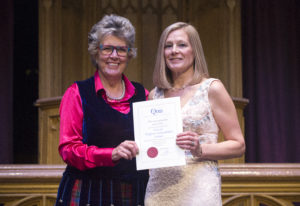While there are no Queen’s Nurses in this role, one of our Fellows, Heather Bain from RGU, has offered up this summary of her role.

Heather Bain
- What is your nursing background?
When undertaking my undergraduate nurse education in the 80s at Foresterhill College I had a two week placement with the district nurse. It was at this time that I knew that this was the role I wanted to aim for. At this time you required to have a minimum of two years hospital experience before working in the community and therefore I gained some experience within surgical and medical nursing before commencing my district nursing training. I was in the first diploma intake of district nursing in Grampian, which I later topped up to a degree at Robert Gordon University. I worked for many years as a district nurse in Grampian and then as a team leader of an integrated team and also being a practice teacher of district nurse students.
- What led you to want to work as a lecturer?
I always had a keen interest in education and in fact when I was at school I actually wanted to be a primary school teacher but at that time there was a shortage of jobs and therefore ‘I fell into nursing’. As a registered nurse and district nurse, I always liked developing staff and teaching students. In 2002 there was an opportunity to move into education at Robert Gordon University to develop and lead on the prescribing programme which I thought would be a great opportunity, having been one of the first prescribers within district nursing in Scotland. The rest is history.
- How long have you worked in the sector?
Since coming into education I have many opportunities. I initially led the V300 prescribing programme as well as doing some teaching within the undergraduate nursing programme. I subsequently became the course leader of the district nurse programme when it was at degree level and over a period of time led it to Masters level. More recently I have had a more strategic role in the School and have responsibility for all academic programmes including nursing , midwifery and paramedic science within Robert Gordon University
- What have been some of the highlights of working as a lecturer?
I have had many highlights working as a lecturing. In 2006 I had the opportunity to undertake a secondment with NHS Education Scotland to work with all the providers in Scotland who delivered prescribing programmes. This led to the development of a national assessment strategy. More recently I have completed my doctorate in education and have had the opportunity for a further secondment with the Nursing and Midwifery Council. This afforded me the opportunity to be involved I the prescribing standards that were published in 2018. And of course I cannot forget being awarded a Fellowship of the Queens Nursing Institute Scotland in 2017.
- What would you say to someone considering moving from practice to lecturing?
Moving into education is not an easy transition. It is a different pace and I always remind new staff there are no emergencies in education, although at times it feels as if there are. However, it is equally rewarding as a career and anyone new to education needs to take their time to orientate themselves to a new environment. In reality it is no different from changing roles within clinical practice.
- Do you miss working with patients on a daily basis?
For me this was the right move. Initially I did miss palliative care – however through working with students and our partners in practice I still have close links with practice .
- Would you be able to return to practice if you wanted to?
I am happy in my current role – however if there was a need to return to practice I am confident I could still make a positive contribution.